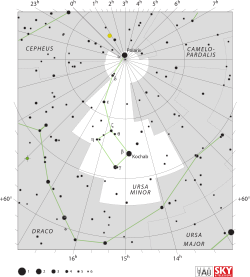Theta Ursae Minoris
| Theta Ursae Minoris (θ) | |
 | |
| Observationsdata Epok: J2000 | |
|---|---|
| Stjärnbild | Lilla Björnen |
| Rektascension | 15t 31m 24,93s[1] |
| Deklination | +77° 20′ 57,67″[1] |
| Skenbar magnitud () | +4,982[2] |
| Stjärntyp | |
| Spektraltyp | K5 III CN0.5[3] |
| B–V | +1,545 ± 0,005[4] |
| Variabeltyp | misstänkt |
| Astrometri | |
| Radialhastighet () | -25,30 ± 0,5[4] km/s |
| Egenrörelse (µ) | RA: -47,55 ± 0,37[5] mas/år Dek.: +5,33 ± 0,42[5] mas/år |
| Parallax () | 3,81 ± 0,37[5] |
| Avstånd | 860 ± 80 lå (260 ± 30 pc) |
| Absolut magnitud () | -2,04 ± [6] |
| Detaljer | |
| Radie | 4,8[7] R☉ |
| Luminositet | 1 618[8] L☉ |
| Temperatur | 3 962 ± 36[9] K |
| Metallicitet | +0,18 ± 0,06[8] dex |
| Andra beteckningar | |
| GEN# +1.00139669, IRC +80031, PPM 8938, 15 Ursae Minoris, GSC 04560-03065, 2MASS J15312494+7720576, RAFGL 1783, AG+77 451, HD 139669, N30 3506, ROT 2213, BD+77 592, HIC 76008, NSV 20342, SAO 8274, FK5 3229, HIP 76008, PLX 3537, SKY# 28090, GC 20952, HR 5826, PLX 3537.00, TYC 4560-3065-1, GCRV 8994, IRAS 15328+7731, PMC 90-93 1366, uvby98 100139669[1] | |
Theta Ursae Minoris (θ Ursae Minoris, förkortat Theta UMi, θ UMi) som är stjärnans Bayer-beteckning, är en misstänkt dubbelstjärna i den mellersta delen av stjärnbilden Lilla björnen. Den har en skenbar magnitud på +4,98[2] och är svagt synlig för blotta ögat där ljusföroreningar ej förekommer. Baserat på parallaxmätningar i Hipparcos-uppdraget på 3,8[5] mas beräknas den befinna sig på ca 860 ljusårs (260 parsek) avstånd från solen.
Egenskaper[redigera | redigera wikitext]
Theta Ursae Minoris är en orange till gul jättestjärna av spektralklass K5 III CN0.5,[3] som anger att den har ett mindre överskott av dicyan i dess yttre atmosfär. Den har en radie som är ca 4,8[7] gånger större än solens och utsänder ca 1 620[8] gånger mera energi än solen från dess fotosfär vid en effektiv temperatur på ca 4 000 K.[9]
Theta Ursae Minoris är sannolikt en spektroskopisk dubbelstjärna med två ungefär lika stora komponenter.[10] Fotometri från Hipparcos satellituppdrag visar att den varierar i magnitud med några hundradels enheter. Den är listad som NSV 20342 i den nya katalogen över misstänkta variabla stjärnor.[11]
Se även[redigera | redigera wikitext]
Referenser[redigera | redigera wikitext]
- Den här artikeln är helt eller delvis baserad på material från engelskspråkiga Wikipedia, Theta Ursae Minoris, 22 april 2019.
Noter[redigera | redigera wikitext]
- ^ [a b c] ”Basic data: * tet UMi – Variable Star” (på engelska). Centre de Données astronomiques de Strasbourg. http://simbad.u-strasbg.fr/simbad/sim-basic?Ident=Theta+Ursae+Minoris&submit=SIMBAD+search. Läst 18 juli 2015.
- ^ [a b] Høg, E.; et al. (2000). "The Tycho-2 catalogue of the 2.5 million brightest stars". Astronomy and Astrophysics. 355: L27. Bibcode:2000A&A...355L..27H. doi:10.1888/0333750888/2862.
- ^ [a b] Keenan, P. C.; McNeil, R. C. (1989). "The Perkins catalog of revised MK types for the cooler stars". The Astrophysical Journal Supplement Series. 71: 245. Bibcode:1989ApJS...71..245K. doi:10.1086/191373.
- ^ [a b] van Leeuwen (2007). ”Hipparcos, the New Reduction” (på engelska). http://vizier.u-strasbg.fr/viz-bin/VizieR-5?-out.add=.&-source=I/311/hip2&HIP=76008. Läst 18 juli 2015.
- ^ [a b c d] van Leeuwen, F. (November 2007), "Validation of the new Hipparcos reduction", Astronomy and Astrophysics, 474 (2): 653–664, arXiv:0708.1752, Bibcode:2007A&A...474..653V, doi:10.1051/0004-6361:20078357.
- ^ Schiavon, Ricardo P. (July 2007), "Population Synthesis in the Blue. IV. Accurate Model Predictions for Lick Indices and UBV Colors in Single Stellar Populations", The Astrophysical Journal Supplement Series, 171 (1): 146–205, arXiv:astro-ph/0611464, Bibcode:2007ApJS..171..146S, doi:10.1086/511753.
- ^ [a b] Pasinetti Fracassini, L. E.; Pastori, L.; Covino, S.; Pozzi, A. (February 2001). "Catalogue of Apparent Diameters and Absolute Radii of Stars (CADARS) - Third edition - Comments and statistics". Astronomy and Astrophysics. 367: 521–24. arXiv:astro-ph/0012289. Bibcode:2001A&A...367..521P. doi:10.1051/0004-6361:20000451.
- ^ [a b c] McDonald, I.; et al. (2012). "Fundamental Parameters and Infrared Excesses of Hipparcos Stars". Monthly Notices of the Royal Astronomical Society. 427 (1): 343–57. arXiv:1208.2037. Bibcode:2012MNRAS.427..343M. doi:10.1111/j.1365-2966.2012.21873.x.
- ^ [a b] Prugniel, Ph.; et al. (July 2011), "The atmospheric parameters and spectral interpolator for the MILES stars", Astronomy & Astrophysics, 531: 25, arXiv:1104.4952, Bibcode:2011A&A...531A.165P, doi:10.1051/0004-6361/201116769, A165.
- ^ Eggleton, P. P.; Tokovinin, A. A. (September 2008), "A catalogue of multiplicity among bright stellar systems", Monthly Notices of the Royal Astronomical Society, 389 (2): 869–879, arXiv:0806.2878, Bibcode:2008MNRAS.389..869E, doi:10.1111/j.1365-2966.2008.13596.x.
- ^ Samus, N. N.; Durlevich, O. V.; et al. (2009). "VizieR Online Data Catalog: General Catalogue of Variable Stars (Samus+ 2007-2013)". VizieR On-line Data Catalog: B/gcvs. Originally published in: 2009yCat....102025S. 1. Bibcode:2009yCat....102025S.
Externa länkar[redigera | redigera wikitext]
| |||||||||||||||||||





